VLAN and LAN are similar; LAN is a collection of various network devices that enable communications between devices, and VLAN is a type of LAN that enhances its capabilities.
Basic LAN has limited capabilities that induce congestion in networks. These networks are divided into different workstations within the LAN to eliminate load and congestion.
This implies that the reason for introducing VLAN is the splitting of those networks.
Although functions are the same, both LAN and VLAN are different in their techniques and properties.
In this article, I’ll discuss each term in detail, including the types, working principles, usage, and more, and also differentiate between LAN and VLAN.
Here we go!
What Is LAN?
A Local Area Network (LAN) is a connection between different computers used to communicate with each other and is limited to a certain geographical area. The area could be an office, school, building, etc. It is a low-cost type of network that involves less expensive networking devices and cabling.
LAN shares multiple information and resources such as software applications, printers, cameras, files, and more to make your work easier. Even if one of the resources is not available locally, you can get resources remotely.
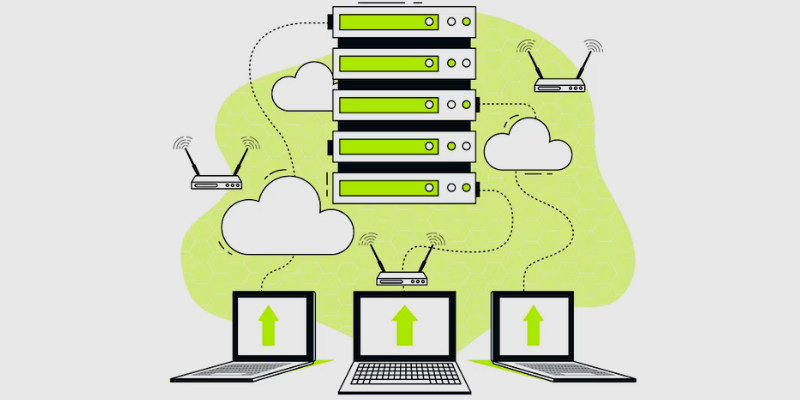
A switch or set of switches connects to a group of devices and computers using TCP/IP protocols. Private addresses are different from other machines’ addresses on a local network. Data gets transmitted at a higher rate due to the limited computer links.
By definition, hardware, such as network adapters, Ethernet cables, hubs, etc., must be inexpensive, and the connection must be high-speed. LAN can be used in several places because the management and setup are straightforward.
For proper communication of LAN networks, there are two mediums – coaxial cables and twisted pair cables. Since both mediums traverse a limited distance, the noise and inaccuracy are minimal. Data speeds on LAN range from 4-16 Mbps.
Nowadays, the data speeds have improved and come in a range of 100-1000 Mbps. The propagation delay in the LAN is relatively short. Smaller LANs can employ two computers, whereas larger LANs can employ thousands of computers.
LANs are usually wired connections. However, you might encounter wireless connectivity in some places. Its fault tolerance is higher, and networks are less congested.
What Is VLAN?
Virtual Local Area Network (VLAN) is a logical representation of networks that groups a subset of different network devices together to share a physical Local Area Network (LAN) by isolating the network traffic for every group.
VLANs can be executed on the higher-end switches. A VLAN allows different networks to function as if they are part of the same LAN. The most advantageous function of a VLAN is that it can reduce network latency, increasing network efficiency and saving network resources.

VLANs are used to help with network management, scalability, and security. It can also be used to maintain traffic flows efficiently. The main specialty of VLAN is that the LAN segments can be contracted and spanned according to the requirement.
The division of a broadcast domain can generate larger bandwidth. Thus, VLAN eliminates the requirement of numerous switches for the subnetworks of an enterprise. Switches are used to implement VLAN, and each port is allotted to a single Virtual LAN.
Ports that exist in the VLAN can allocate broadcasts. It also secures your connection by restricting broadcast to each port and building numerous broadcasts from a single one.
VLAN offers a greater amount of flexibility as the ports can be switched if required. It reduces cost and eliminates the need to purchase costly switches to differentiate sub-networks. VLAN implements a hierarchical network that addresses a scheme from which you can assign IP addresses to the network segment.
VLAN ranges:
Some important ranges of VLAN:
- VLAN 0-4095: Reserved VLAN that can’t be used or seen
- VLAN 1: This is a default switch that you can’t delete or edit, but it can be used
- VLAN 2-1001: A normal VLAN range that can be created, edited and deleted
- VLAN 1002-1005: These are CISCO defaults used for FDDI and token rings. This can’t be deleted
- VLAN 1006-4094: These are the extended range of virtual LANs
The primary purposes of VLANs include:
- To improve the performance of devices by reducing the traffic that a given endpoint can process or see.
- VLAN improves network security by allowing a higher control over which the devices can access each other. For example, network teams restrict some management access to the IoT devices or network gear to specific VLANs.
- VLAN is also used to ease administration that allows administrators to group different devices for nontechnical purposes. For example, administrators put all accounting devices on the same VLAN and human resources computers on some other VLANs.
LAN vs. VLAN: Types
Types of LAN
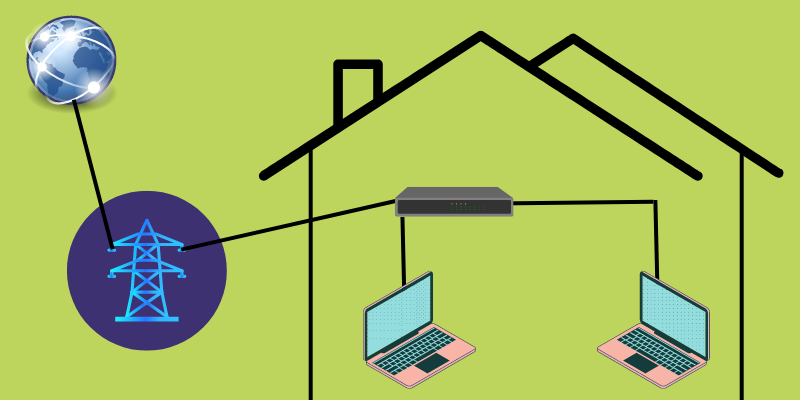
There are two types of LAN:
#1. Wired LAN
A wired LAN uses Ethernet cabling and switches to connect servers, IoT devices, and endpoints to corporate networks. For small businesses, a wired LAN contains a single, unmanaged LAN switch along with many Ethernet ports to interconnect all the devices.
But larger LANs can connect thousands of devices but require additional software, hardware, and configuration steps to make sure the network is performing well.
#2. Wireless LANs
The wireless LAN uses IEEE 802.11 specifications in order to transfer data between the network and end devices using a wireless spectrum. Wireless LAN is preferable to a wired LAN due to its cost savings and flexibility capabilities.
Types of VLAN
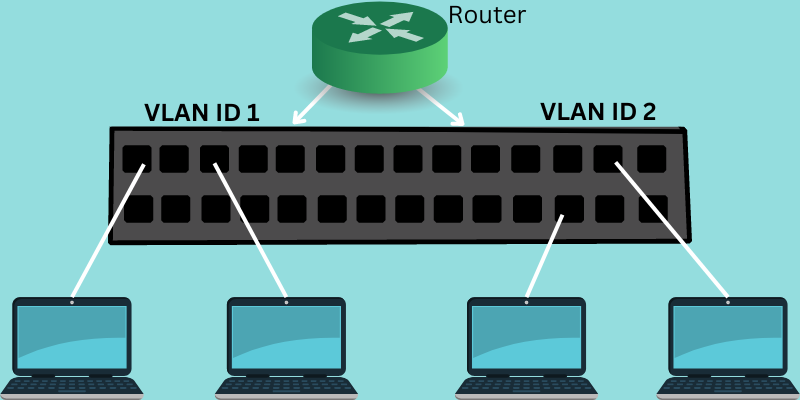
VLANs are of two types:
#1. Port-based or static VLAN
Network engineers create static VLAN by distributing ports on the network switch to a single VLAN. Those ports communicate with the assigned VLANs only. It is important to understand that port VLANs are not truly static since the VLANs assigned to the ports can be changed manually on the fly or by network automation.
#2. Use-based or dynamic VLAN
Network engineers create this type of VLAN by handing over traffic to the VLAN dynamically, based on the device creating traffic or traffic type. A port is assigned to the VLAN based on the device identity as indicated by the security certificate or network protocols in use.
One port is associated with several dynamic VLANs. Changing the device connected through a port or the existing device in use might result in changing the VLAN assigned to a port.
LAN vs. VLAN: How Do They Work?
How Does LAN Work?
LAN requires essential components for the operation:
- Interface to the network: Interfaces include electronic and computer devices that work as the endpoints to send and receive data.
- Interconnections: It supports the traveling of information or data from one place to other. Network media and NIC are part of interconnection. The wireless media and cables in the network media are used to transfer signals. The function of a Network Interface Card (NIC) is to convert the information into a form that can be transmitted easily over the LAN.
- Network devices: Network devices are switches, hubs, and routers. These devices work as an assembly of devices that connects the different LAN segments or interfacing devices. Switches and hubs are layer 2 devices, whereas the router operates at network layer 3.
- Protocols: Protocols control the transmission of several data over the Local Area Network. Protocols are ARP, DHCP, IP, etc.
How Does VLAN Work?
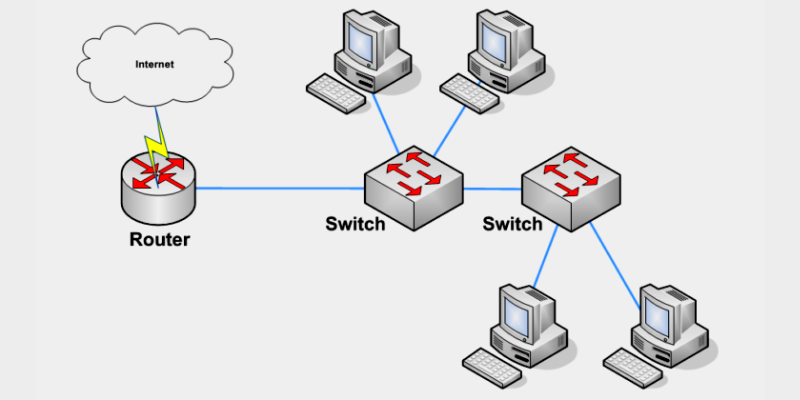
A VLAN is detected on the network switch by VLAN ID. Each port on the switch has one or more VLAN IDs allotted to it. It will land in a VLAN default if no other port is allotted. Every VLAN gives data link access to the hosts connected to the switch ports that are configured with their VLAN ID.
A VLAN ID is then translated to the VLAN tag, which is a 12-bit field in the data header of each Ethernet frame that is sent to the VLAN. Since the tag is 12-bits long, VLANs up to 4096 can be defined as the switching domain. VLAN tag is defined by the IEEE in the 802.1Q standard.
There will be no VLAN tag when the Ethernet frame is obtained from a host already attached. The switch then adds the VLAN tag. In a port-based VLAN, the switch enters the tag associated with the port’s VLAN ID. Whereas in a use-based VLAN, it enters the tag associated with the device’s ID or traffic type it generates.
Switches then forward the tagged frames to their destination, forwarding only to the ports where VLAN is associated. Unknown unicast, multicast, and broadcast traffic is forwarded to all the ports in VLANs. When a frame makes it to the destination switch port, the VLAN tag is detached before transmission of the frame begins to its destination device.
LAN vs. VLAN: Advantages and Disadvantages
Advantages of LAN
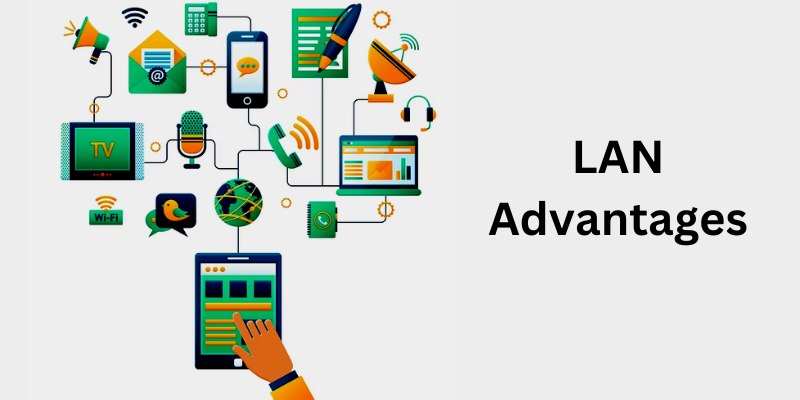
- LAN is an inexpensive transmission media
- It simplifies the physical association of the device with the media
- It is used for high data transmission rates
- Interconnection between different devices is more
- LAN is growth-oriented and flexible
- LAN allows file locking
- You will get a full-proof security system against unauthorized access to data
Disadvantages of LAN
- LAN needs a memory area in every mainframe used on your network. This will decrease the available space for the user’s program.
- LAN adds a phase of difficulty to your computer operation. Users might face understanding problems with network commands. The authority and installation of LAN need regulatory and technical skills.
- Some current applications will fail to run in the provided network environment.
Advantages of VLAN

- VLAN solves major broadcast problems.
- It reduces the broadcast domain size.
- With VLAN, you can add an extra layer of security.
- It helps manage devices smoothly and easily.
- You can group devices by their function instead of their location.
- VLAN allows you to make groups of connected devices so that they can act like they are on the same network.
- It helps you logically segment networks based on project teams, functions, or departments
- You can geographically structure the network.
- You will get higher performance.
Disadvantages of VLAN
- A packet might be leaked from one VLAN to another.
- An injected packet lead to cyber-attacks.
- You will need an additional router to manage the workload in the larger networks.
- You can face interoperability problems.
- A VLAN is not able to forward network traffic to another VLAN.
LAN vs. VLAN: Applications

Applications of LAN
- LAN is used in offices, hospitals, schools, etc., as it allows sharing of several resources like sharing data, printing, internet, scanners, and more.
- LAN also serves users to access the internet at home.
- It is widely used in manufacturing industries to coordinate different activities of machines.
- High-speed LANs are used to connect slower networks together.
Applications of VLAN
- VLAN is useful when you face a lot of traffic on your LAN.
- When you have more than 200 devices in your network, VLAN is used.
- When a group of users requires advanced security, you will need a VLAN.
- When devices become slowed down by different broadcasts, VLAN is an ideal option.
- VLAN is used to make a single switch to numerous switches.
LAN vs. VLAN: Differences
Setting a LAN is an expensive arrangement, whereas setting a VLAN is an intelligent arrangement strategy.

Both terms have several differences. Let’s discuss them in a tabular form.
| LAN | VLAN |
| LAN is defined as a computer and peripheral device group that are connected within an area. | VLAN is defined as a custom network that is crafted from one or more LANs. |
| LAN works on a single broadcast domain. | VLAN works on a number of broadcast domains. |
| It was first introduced in the 1970s. | It was first introduced in 2003. |
| The cost of LAN is high. | The cost of virtual LAN is less. |
| The latency is high. | The latency is low. |
| The devices used are routers, switches, and hubs. | The devices used are switches and bridges. |
| LAN uses standard Ethernet protocols, such as FDDI and token rings. | VLAN uses VTP and ISP standard protocols. |
| The maximum range of connection is 2 miles. | The connection has a similar range. |
| In LAN, the packet is implemented in each device. | In VLAN, the packet is sent to a particular broadcast domain. |
| LAN is less efficient. | VLAN is highly efficient. |
| To use LAN, you won’t need any information. | To use VLAN, users must know multiple commands in order to configure VLAN. |
| LAN is not secure enough. Security measures are taken at the router’s end. | It improves security. |
| LAN filters the frames only and is less scalable. | It specifies the protocols and ports to detect the frame. |
Conclusion
Virtual Local Area Network (VLAN) is an extension of the Local Area Network (LAN), where LAN capabilities are enhanced by segmenting it logically into several broadcast domains. This partition creates numerous LANs logically in a single bridge or switch, hence reducing cost and traffic while increasing the administration’s convenience, security, and performance.
Thus, virtual LAN provides ease of management and troubleshooting with better security of all the network devices in use.
You may also explore the best internet speed test tools to check your Wi-Fi and mobile bandwidth.
Si quiere puede hacernos una donación por el trabajo que hacemos, lo apreciaremos mucho.
Direcciones de Billetera:
- BTC: 14xsuQRtT3Abek4zgDWZxJXs9VRdwxyPUS
- USDT: TQmV9FyrcpeaZMro3M1yeEHnNjv7xKZDNe
- BNB: 0x2fdb9034507b6d505d351a6f59d877040d0edb0f
- DOGE: D5SZesmFQGYVkE5trYYLF8hNPBgXgYcmrx
También puede seguirnos en nuestras Redes sociales para mantenerse al tanto de los últimos post de la web:
- Telegram
Disclaimer: En Cryptoshitcompra.com no nos hacemos responsables de ninguna inversión de ningún visitante, nosotros simplemente damos información sobre Tokens, juegos NFT y criptomonedas, no recomendamos inversiones


